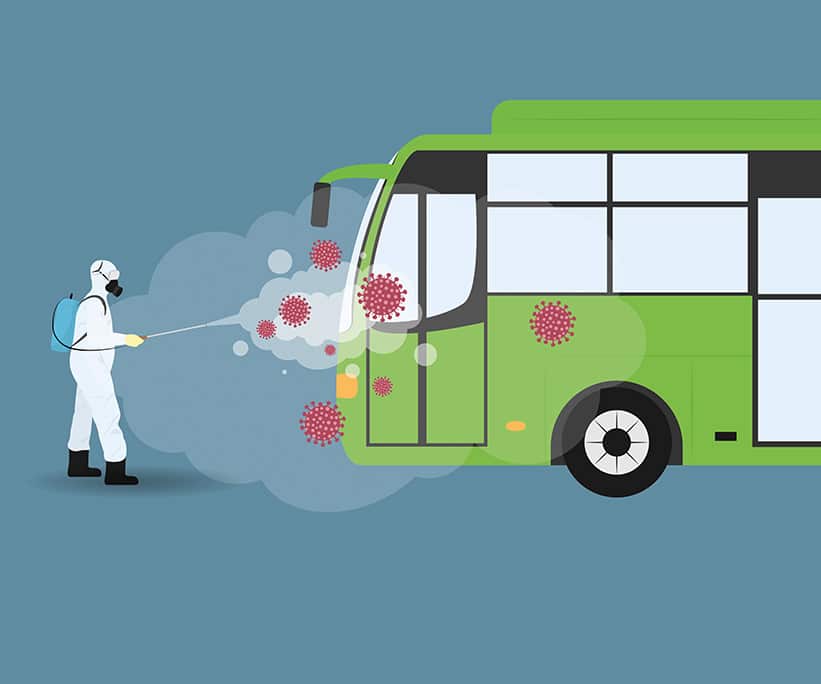Croner-i explains the key advice given in the government’s COVID-secure guidance for working in, or from, vehicles
The government guidance – Coronavirus (COVID-19): Safer Transport Guidance for Operators – provides practical instructions for transport operators on how drivers can work safely during the current pandemic.
There are three initial points to consider:
- Each business needs to translate this information into specific actions based on their own situation (e.g. size/type of business, how it is organised, operated and regulated)
- Nothing indicated in this guidance supersedes a transport operator’s normal obligations to health and safety, non-discrimination, and equalities legislation
- Account must be taken of agency workers and contractors as well as regular employees when applying this guidance.
Safety checklist
The government has identified six priority actions for businesses to take in order to protect their staff and customers:
- Complete a COVID-19 risk assessment. Update it regularly and share it with staff
- Provide adequate ventilation, preferably with a supply of fresh air
- Clean surfaces more often, especially those that are touched. Staff should use hand sanitisers and wash their hands regularly
- Enable people to check in at your venue, to support NHS Test and Trace (no longer legally required)
- Turn people with COVID-19 symptoms away. Staff members or visitors who have a persistent cough, a high temperature or have lost their sense of taste or smell, should be isolating. Employers are committing an offence if they require someone who is required to self-isolate to come to work
- Keep all workers, contractors and visitors up to date with your safety measures.
Carrying out a coronavirus risk assessment
Accepting an awareness of the normal risks to their business, operators must direct their present focus on the unprecedented problems posed by COVID-19. While recognising that it is impossible to eliminate all risks associated with the virus, the assessment must take account of all reasonably practicable steps.
This means identifying sensible measures and the government has emphasised the need to consult staff when preparing for a return to work. Transport operators must also share the results of their risk assessment with their workforce by publishing the results on their website, if possible.
The risk assessment should also include an up-to-date plan of the premises in case there is a COVID-19 outbreak. This plan should nominate a single point of contact where possible, who should lead on contacting local public health teams.
Managing risks
Good ventilation is a key control measure. Enclosed spaces are thought to increase the risk of transmission and fresh air helps to dilute the virus in occupied spaces, so adequate ventilation using windows, vents or mechanical ventilation should be ensured.
Regular handwashing should be maintained, to which the transport operator must add regular and careful cleaning of premises and vehicles (with particular reference to surfaces that are subject to repeated touching such as handles, fuel pumps and vehicle keys).
Meaningful consultation with employees about returning to the workplace should include a discussion of the timing and phasing of any return and any risk mitigations that have been implemented. It is vital employers engage with workers to ensure they feel safe returning to work and no one should be forced into an unsafe workplace.
COVID secure measures should also continue even if employees have recently tested negative or had one or both doses of the vaccine.
Staying on top of the problem
It will be important to plan for the minimum number of workers needed and deployed in the field in order to operate safely and effectively. Their health and well-being must be monitored, without forgetting colleagues who are unable to return to work.
The organisation must be aware of those of its employees who are considered to be clinically vulnerable and at higher risk of severe illness. Particular attention should also be paid to people who live with clinically extremely vulnerable individuals.
All things being equal
Operators must communicate appropriately with workers whose protected characteristics might either expose them to a different degree of risk or make any potential roles inappropriate or challenging for them.
For example, the need to deal with the specific problems presented by COVID-19 must not divert attention from the legal duty to make reasonable adjustments to avoid disabled workers being put at a disadvantage.
It is also important to note that any steps taken do not have an unjustifiable negative impact on some groups compared to others, for example, those with caring responsibilities or those with religious commitments.
On the move
Particular attention needs to be paid to times when sites and depots are at their busiest. Operators should consider the following wherever possible:
- Staggered arrival and departure times
- The provision of additional parking, to avoid crowding, or facilities to help people walk, run or cycle to work
- Assigning fixed groups of workers to the same transportation routes where sole travel is not possible
- Restricting the use of works vehicles such as minibuses to avoid over-crowding
- Scheduling goods deliveries away from rush hours and loading and unloading where possible without involving the driver
- Providing sufficient quantities of hand sanitiser/wipes within vehicles to enable workers to clean hands after each delivery
- Setting clear use and cleaning guidance for showers, lockers and changing rooms
- Avoiding two-person deliveries, even if this means delaying the supply of heavier items. Where this is not possible, keep the same two people together as a team
- Reminding drivers of the importance of good ventilation (driving with a window open)
- Identifying areas where people have to directly pass things to each other (such as job information, spare parts, samples, raw materials) and finding ways to remove direct contact, for example, by using drop-off points or transfer zones
- Briefing drivers and temporary staff on a regular basis, communicating new arrangements to customers and providing in-vehicle guides and reminders
- Maximising use of electronic paperwork and reviewing procedures to enable safe exchange of paper copies where needed (required transport documents, for example)
- Encouraging drivers to stay in their vehicles where this does not compromise their safety and existing safe working practice.
Emergencies
If an accident or an emergency occurs, such as a fire, the response will override the measures put in place to deal with the current crisis and attention should be paid to this possibility, for example where barriers introduced to promote social distancing affect the route of an emergency exit.
People involved in the provision of assistance to others should pay also particular attention to sanitation measures immediately afterwards, including washing hands.
Face coverings
Face coverings are not a replacement for other risk control measures. However, they do play a role in protecting others from the larger droplets expelled by the wearer when talking, etc.
Face coverings are no longer mandatory on public transport but many businesses and transport providers, including Transport for London, are continuing to recommend their use. A face visor or shield may be worn in addition to a face covering but not instead of one, unless the wearer is exempt.
If employees wish to wear a face covering, they should be encouraged to do so.
The evidence shows that wearing a face covering in an enclosed space helps protect people around you from COVID-19 and people are now being encouraged to wear face coverings in enclosed public spaces where there are people they do not normally meet.
Workplace testing
Regular testing could help identify asymptomatic cases of COVID-19 in the workplace. Regular asymptomatic testing for staff who cannot work from home should occur even if employees have:
- received a recent negative test result
- had the vaccine (either 1 or 2 doses).
Where testing on-site is provided it is essential that it is carried out in a safe manner and in an appropriate setting.
The government has stopped the supply of free rapid lateral flow tests for employers to test employees with no COVID-19 symptoms. In future, they must either buy their own tests and set up their own workplace testing or pay an approved provider to provide tests or run a test site for them. Separate advice is available for employers in Scotland, Wales or Northern Ireland.
Self-isolation
Workers who have symptoms of COVID-19 or workers living in a household or support bubble with someone showing symptoms of COVID-19 should self-isolate, stay at home and arrange to have a test to see if they have COVID-19.
Those who may have had contact with a colleague who has been diagnosed with COVID-19 may be contacted as part of the Test and Trace service and in such cases would also need to self-isolate if directed to do so. The fine for breaching self-isolation rules starts at £1000. This could increase to up to £10,000 for repeat offences and for the most serious breaches, including for those preventing others from self-isolating.
There are also some exceptions from self-isolation for employees in certain sectors and at the current time this is only expanded to cover those involved in essential transport.
In-depth guidance on transport and COVID-19 security is available as part of a subscription to Transport-inform, which is available at a discount to routeone members.



























